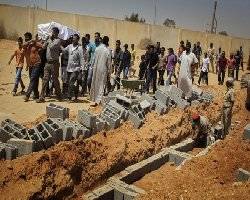The conflict in Libya will continue to take its toll on communities long after the war has ended as long as hidden bombs remain scattered across public areas.
Fifteen-year-old Misrata resident Mohammed lost most of his left hand and sustained shrapnel injuries to his abdomen in April after an unexploded ordnance found near his house detonated in his hands while he was playing.
Cluster munitions or cluster bombs are air-dropped or ground-launched explosive weapons that can eject up to 2,000 sub-munitions, or bomblets.
Unexploded ordnances (UXO) of cluster bomblets or sub-munitions are usually left behind after a strike and are designed to detonate at a later time, making their indiscriminate effects — of killing or maiming civilians — felt long after the attack has occurred.
“Cluster bombs cause two major risks: First, their widespread dispersal means they cannot distinguish between military targets and civilians, so the immediate humanitarian impact can be extreme, especially when the weapon is used in or near populated areas,” Cluster Munition Coalition (CMC) Director Laura Cheeseman told IPS. “Secondly, many sub-munitions fail to detonate on impact and become de facto anti-personnel mines, killing and maiming people long after the conflict has ended. These ‘duds’ are more lethal than anti-personnel mines — incidents involving sub-munitions ‘duds’ are much more likely to cause death than injury.”
Adopted in May 2008 in Dublin, Ireland, the Convention on Cluster Munitions prohibits ratifying nations from using cluster munitions. The convention, which became international law in August 2010, has been ratified by 55 states out of 108 signatories.
“During last month’s intercessional meetings of the 2008 Convention on Cluster Munitions there were repeated calls made by both the CMC and by states parties condemning Gadhafi’s use of these indiscriminate weapons, and for Libya to join the convention as soon as the conflict is over,” said Cheeseman.
Since late March, NATO has conducted nearly 6,000 bombing missions — including 382 strikes on ammunition-storage facilities.
NATO operations has added new risks to the already thousands of unexploded ordnances strewn across residential areas.
“There’s a danger with the NATO strikes because in the attack the ammunition will be kicked out, which means the items are scattered in the surrounding areas, posing a threat to civilians until they’re cleared up,” Mark Hiznay, arms researcher at Human Rights Watch (HRW), told IPS.
In Benghazi, Tobruk, and Zintan, civilians have been gaining access to munitions that were stored in military facilities. They are wandering into contaminated environments, and this causes another problem because “these ordnances could be unstable [and] explode with one touch or when handled,” Hiznay said.
“Land mines are also increasingly becoming a big issue, with the latest reports of minefields being laid on the outskirts of Zintan not far from Misurata in an area that’s agricultural land, so that’s a worrying development,” adds Sutton.
Last week, Libyan researchers with the HRW discovered at least three minefields laid by forces loyal to Muammar Gadhafi — containing anti-personnel and anti-vehicle land mines on the outskirts of the Libyan village of al-Qawalish in the western Nafusa Mountains.
According to HRW, all three minefields were located in heavily populated civilian areas and many of the nearly 240 anti-personnel mines were Brazilian-made, while the approximately 46 anti-vehicle mines were manufactured in China.
“The Brazilian-made anti-personnel mines we discovered are very small, made almost entirely of plastic, and can be difficult to detect with metal detectors in a large desert area — but these mines are no longer available because Brazil is a party to the Mine Ban Treaty and hasn’t manufactured or sold them since 1989,” stressed Hiznay. “However, the fact that we’re seeing so many Chinese mines is of concern because China has failed to sign any of the conventions. Hopefully, measures like the Arms Trade Treaty (ATT) would begin to address this unregulated trade to regimes that have poor human rights records.”
Libya is one of 37 nations that have not joined the 1997 Mine Ban Treaty — which bans the use, production, and transfer of all anti-personnel mines and requires destruction of stockpiles within four years, clearance of mined areas within 10 years, and assistance to land mine victims.
PHOTO CAPTION
Libyans carry a coffin during a funeral in Benghazi, Libya, Sunday, July 17, 2011.
Source: Agencies


 Home
Home Discover Islam
Discover Islam Quran Recitations
Quran Recitations Lectures
Lectures
 Fatwa
Fatwa Articles
Articles Fiqh
Fiqh E-Books
E-Books Boys & Girls
Boys & Girls  Ramadan
Ramadan Fatwa Audios
Fatwa Audios Month of Mercy
Month of Mercy Women
Women Eed Al- Fitr
Eed Al- Fitr Food Recipes
Food Recipes Videos
Videos

 Prayer Times
Prayer Times












